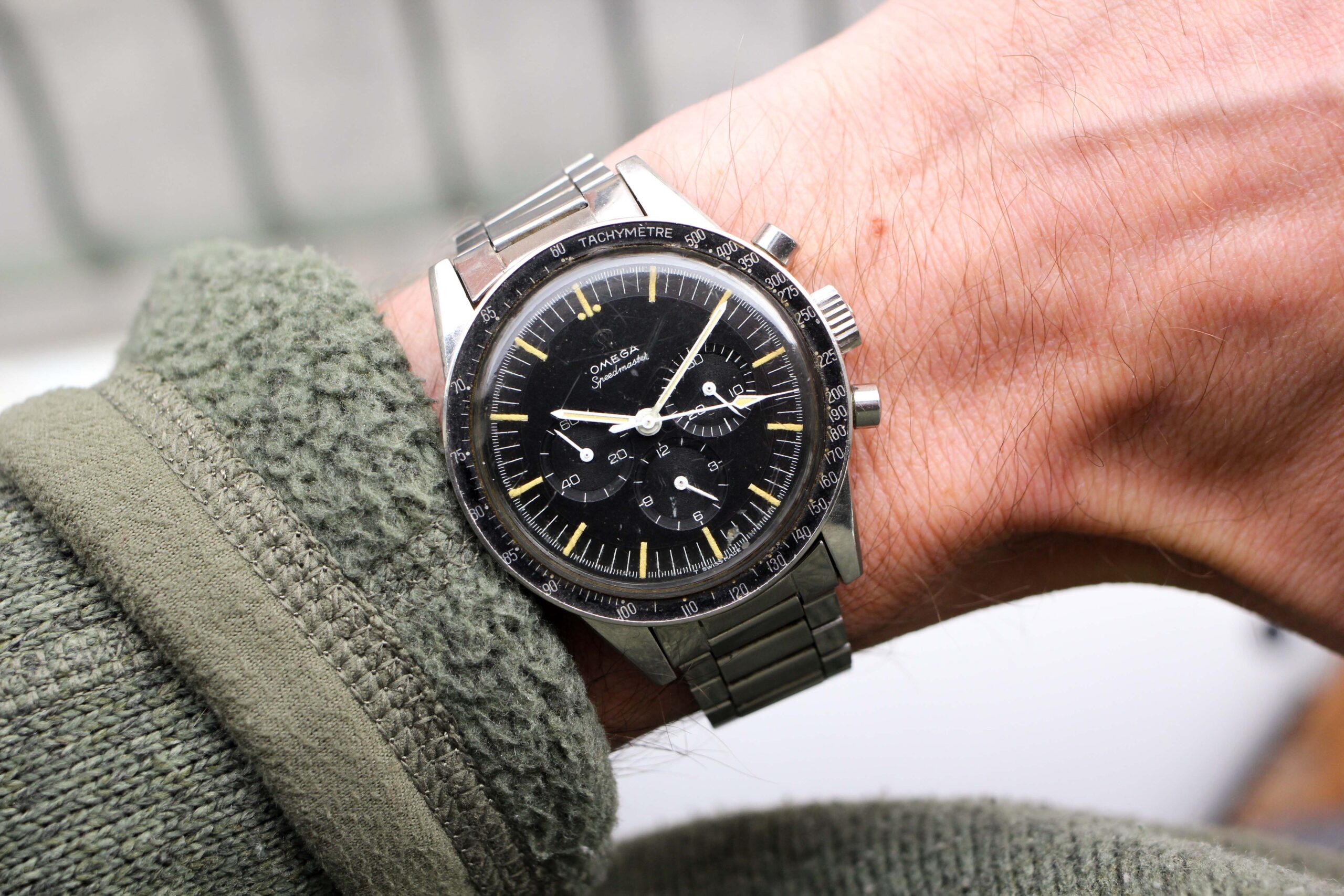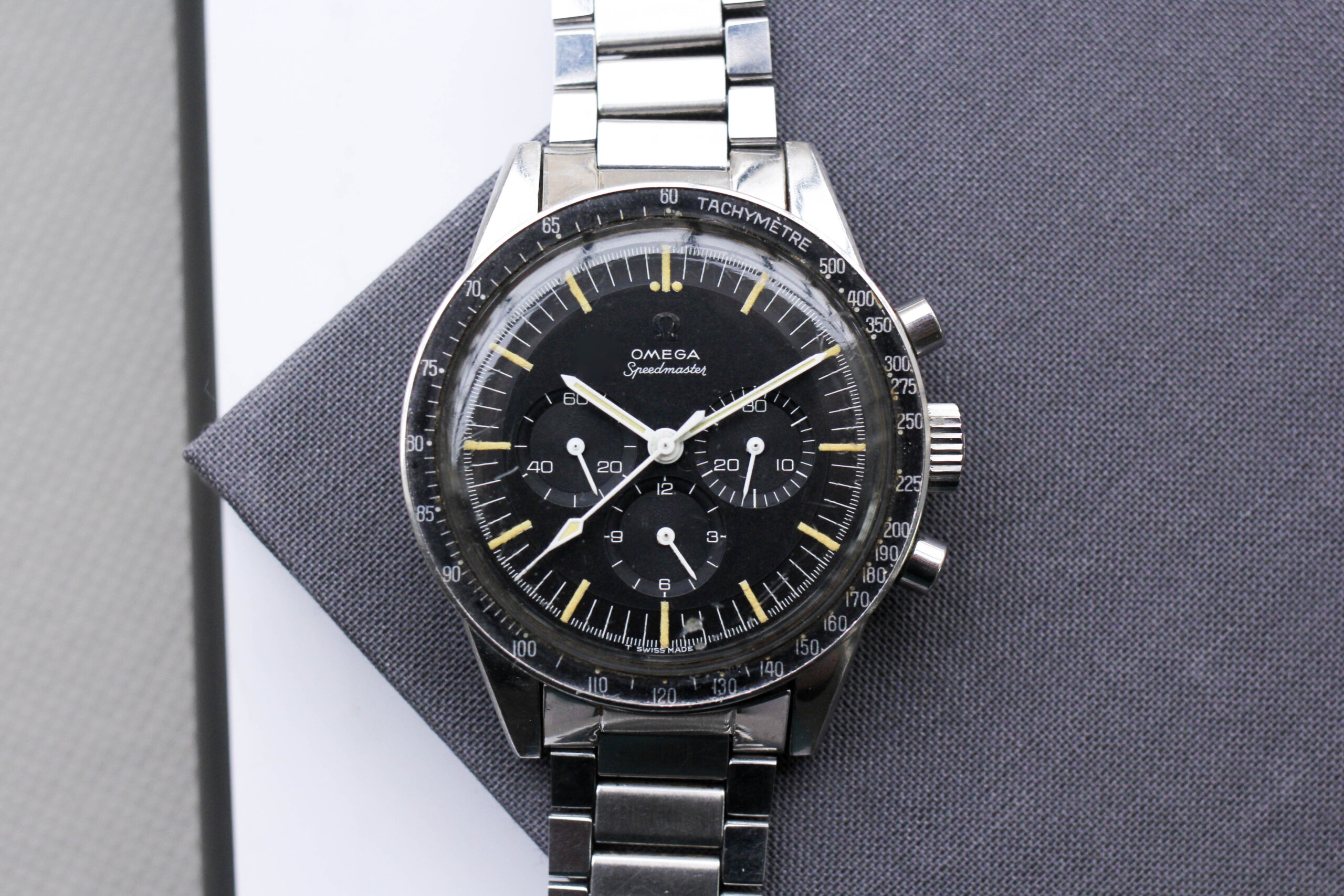If you’ve followed my collection for any meaningful period of time, you’ll know that while my tastes ebb and flow, one thing is clear: I will never tire of the Omega Speedmaster. There are many terrific reference guides that provide granular detail on each Speedmaster reference (such as Speedmaster101.com or Moonwatch Only), so I will not provide an exhaustive overview of the Omega Speedmaster Ed White (reference 105.003) in this article. However, it is worth providing some context for where the 105.003 fits within the Speedmaster world.
Understanding The Reference
As noted above, the watch featured in this article is a reference 105.003, which represents the final iteration of the straight lug Speedmaster and was the model worn by famous astronaut Ed White (hence the common nickname – the “Ed White”). The reference 105.003 was produced from 1963-1966 and had the highest production numbers of any straight lug Speedmaster. Early in my collecting journey, collectors often overlooked Ed Whites by saying they were “too common” and were “the least interesting design” of any of the straight lug references. These statements aren’t exactly wrong – it was produced in higher numbers than any other straight lug reference, and the dial and handsets essentially set the template for all subsequent Speedmasters – but eventually, public opinion began to shift and the link between Ed Whites and all subsequent Speedmasters imbued the reference with more importance.
Today, there is strong demand for well preserved Ed Whites. The overwhelming majority of these watches were used (hard) throughout their lives, and now exhibit dial damage, replaced parts, or overpolished cases. To find a “mint” example is like finding a needle in a haystack…and that is exactly what led me to make one of the worst impulse purchases of my watch collecting life.
The Story Behind “The Gamble”
As my tastes have evolved and been refined over the years, I find myself drawn towards condition more than provenance – a watch may have a great story, but if the dial is degraded or the case is polished to a nub, I won’t enjoy it as much as an example in mint condition with no story at all. This realization has largely shaped how I collect now, with a less structured approach to chasing down specific watches / references and a broader eye for top condition examples. I have also become incredibly rigorous about vetting the originality of a watch and not accepting unnecessary risks…except for this watch. This was an ill-informed gamble. Do as I say, not as I do.
Vintage “pre-moon” Speedmasters are the watches that I feel most comfortable evaluating with imperfect information. This confidence has been earned through almost a decade of buying and selling vintage Speedies (28 now, by my count), and my analysis of a potential purchase has become extremely regimented, largely as a means of avoiding earlier mistakes that I’ve made along the way.
Over the years, I have honed my discipline with Speedmasters to a level that rivals Neil McCauley’s credo in the movie Heat – if a Speedmaster doesn’t have a great dial, original hands with closely matching patina, and fully original parts, I’m walking out. But just as Neil McCauley lets temptation get the best of him and temporarily abandons his discipline in Heat, I felt myself drawn in by a suspiciously good Ed White that was coming up for sale at auction.
While scrolling through an auction aggregator, my eyes were immediately drawn to the above picture of an Omega Speedmaster Ed White that would soon be auctioned off by a small auction house in upstate New York. Hell, with patina that vibrant, it was impossible to miss. Many others had taken note as well, as the “Watcher” count was well over 150 people and it was still weeks before the auction. I was skeptical that the watch was original, but I registered for the auction and planned to reach out for more information prior to the big day.
Experience with handling watches in the metal counts for a lot in the world of vintage watches, and while I had come across many, many Ed White examples over the years, I couldn’t recall any that had such a saturated yellow patina. That was the first “tell” that something may have been amiss, and likely was enough to scare off many would-be bidders from the jump.
What really piqued my curiosity, however, was how perfectly the patina in the handset matched the plots on the dial. While patina on original watches should typically be closely matched (within a shade or two), the perfect symmetry of the heavily saturated patina on the dial and hands seemed unusual. I remained skeptical of its authenticity but was curious what somebody would be willing to pay for it.
As often happens in life, my intentions to follow-up with the auction house for more details about the watch ultimately tumbled down my to-do list, lost in a cascading prioritization of work and family obligations. The auction took place on a Saturday afternoon, and on Friday night, my calendar alerted me to the fact that it was occurring the following day. I pulled up the catalog again and began sifting through the pictures on a more granular level.
Upon closer inspection, the lume on the dial did not show any of the trademark signs of reluming. These signs typically include the luminous material having a “sheen” to it, overly perfect application (i.e. all lines are perfectly straight and encompass the full underlying white plot on the dial), or on the flip side, very imperfect application that results in squiggles or patterns that would never have passed Omega’s quality control. The hands also showed a similar consistency within the luminous material and there were no obvious signs that the hands themselves had been repainted.
Finally, there was the unprepared nature of the lot. The crystal was covered in scratches and dents, while the case and bezel were caked in dirt and detritus. It is true that for highly valuable vintage watches (particularly Rolex), many people have gone to great lengths to falsely prepare a watch as a “barn find,” but for an Omega Speedmaster Ed White, this level of preparation wouldn’t have a very high ROI. Maybe, just maybe, the example was genuine after all…except that perplexing shade of patina.

The next day, I unwittingly made plans to visit a brewery with a friend at the same time as the auction’s start, which didn’t seem like a big deal since I wasn’t planning to bid. I hadn’t even asked the auction house for better pictures in natural lighting! But as the auction began to play out, I found myself checking the lot progress every 10 minutes or so. My friend, curious as to why I kept opening my phone, was soon asking about the lot I wanted to watch, and I found myself explaining why I couldn’t bid on it. As we grabbed another round of beers, the lot began to inch closer and I decided to just keep the bidding portal open through the lot’s conclusion.
As the lot was introduced, bids started steadily coming in, inching upwards past $10,000, then $11,000, then $12,000. But as it got to $13,000, the bidding stopped. “This is too cheap, even if it is a complete dice roll,” I said to my friend. As the “Fair Warning” flashed, I grimaced as I slid the “bid” bar across and submitted a $13,500 bid. “Someone will come over the top of me, it won’t go this cheap,” I said.
To my consternation, fake confetti soon flew across the screen to congratulate me on my purchase. I had accidentally won the watch, and for a not insignificant price of ~$17,000 after buyer’s premium. I was going to need another beer to process what I’d just done – my finely honed discipline had been thrown to the wind.
I put the auction out of my mind (as much as I could) for the remainder of my time at the brewery, but upon returning home, I opened a group chat that included Sacha Davidoff (one of the foremost Speedy experts in the world) and Adam Golden (owner of Menta Watches) and texted “Welp, I accidentally won a Speedy at auction.” Immediately, they pounced.
“Tell me it wasn’t this one. That was you?! Dude it’s re-lumed, 100%! You know better than to fall for this!” Buyer’s remorse started rising in my gut, and more than the dollars I would inevitably lose on the gamble, my pride was seriously wounded. I had owned nearly 30 Speedmasters over the years – why the hell did I just make a mistake that was so obvious, even to me?
The following week was among the most nerve-wracking of my watch collecting life. As the delivery date neared, it was all I could do to focus on work and not revisit pictures from the auction listing or count down to the expected delivery window. Eventually, the white FedEx truck arrived out front and I leapt down my stairs to greet the delivery person at the door. I don’t remember a time when I was more nervous to open a package, and frankly, it’s a feeling that I will try to not replicate again.
As I tore open the box and unraveled the layers of bubble wrap, I slowly rolled the watch over in my hand and audibly yelled (and I mean yelled) “YES!!!!” as soon as the dial was visible. The yell was so loud, in fact, that my wife ran into the kitchen from the other side of the house to make sure I hadn’t been screaming for a different reason.
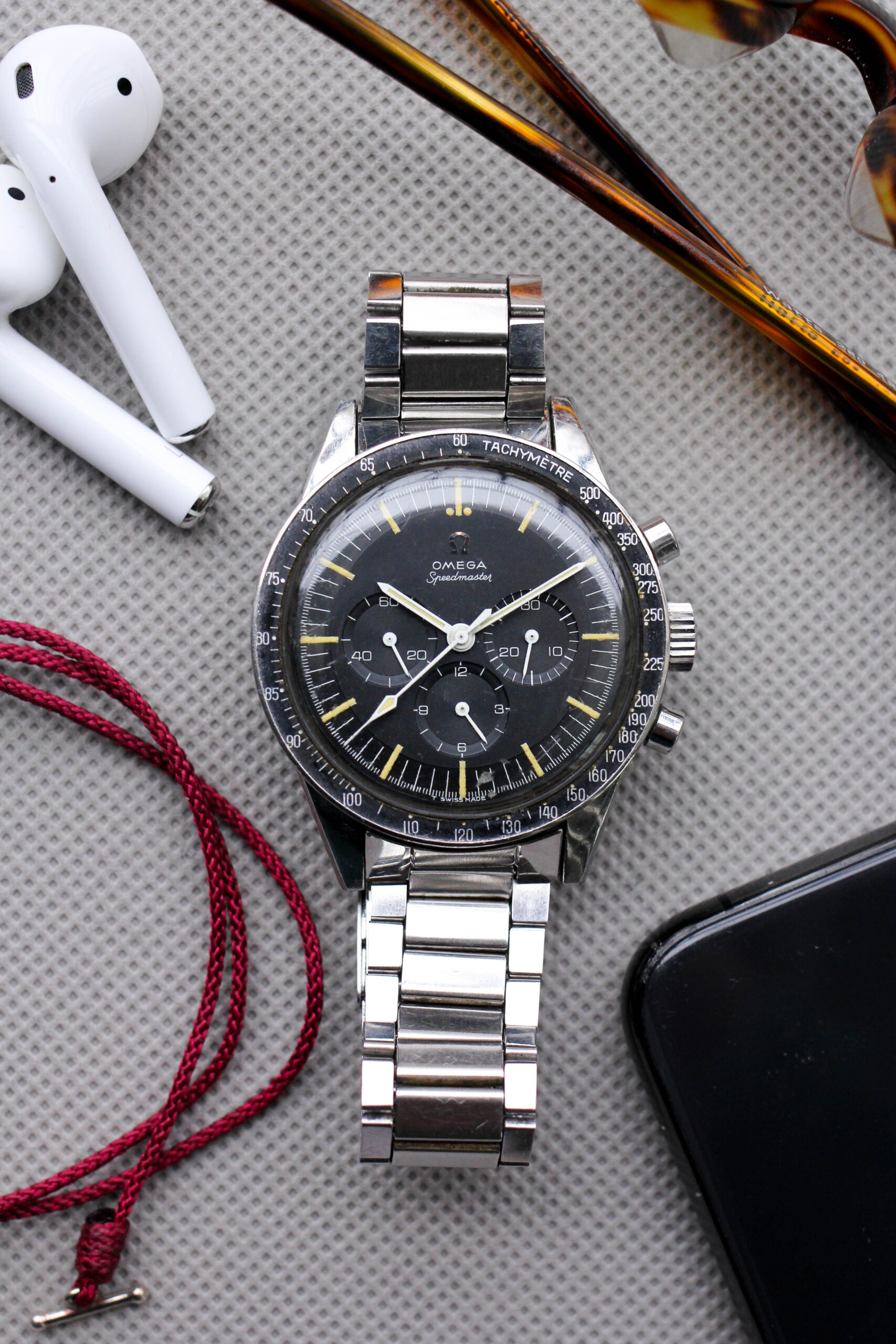
Staring closer at the dial, it was clear that the pictures had been subject to poor color correction or editing. The patina, while still vivid, was a shade that is acceptable for vintage Speedmasters, and under a UV torch, the luminous material reacted identically to my CB Speedmaster that was produced in 1966 (and was produced very closely to this one). I turned the watch over again and confirmed that the watch certainly had not been prepared at all prior to sale. Grime and detritus caked the bezel, bracelet, and underside of the lugs.
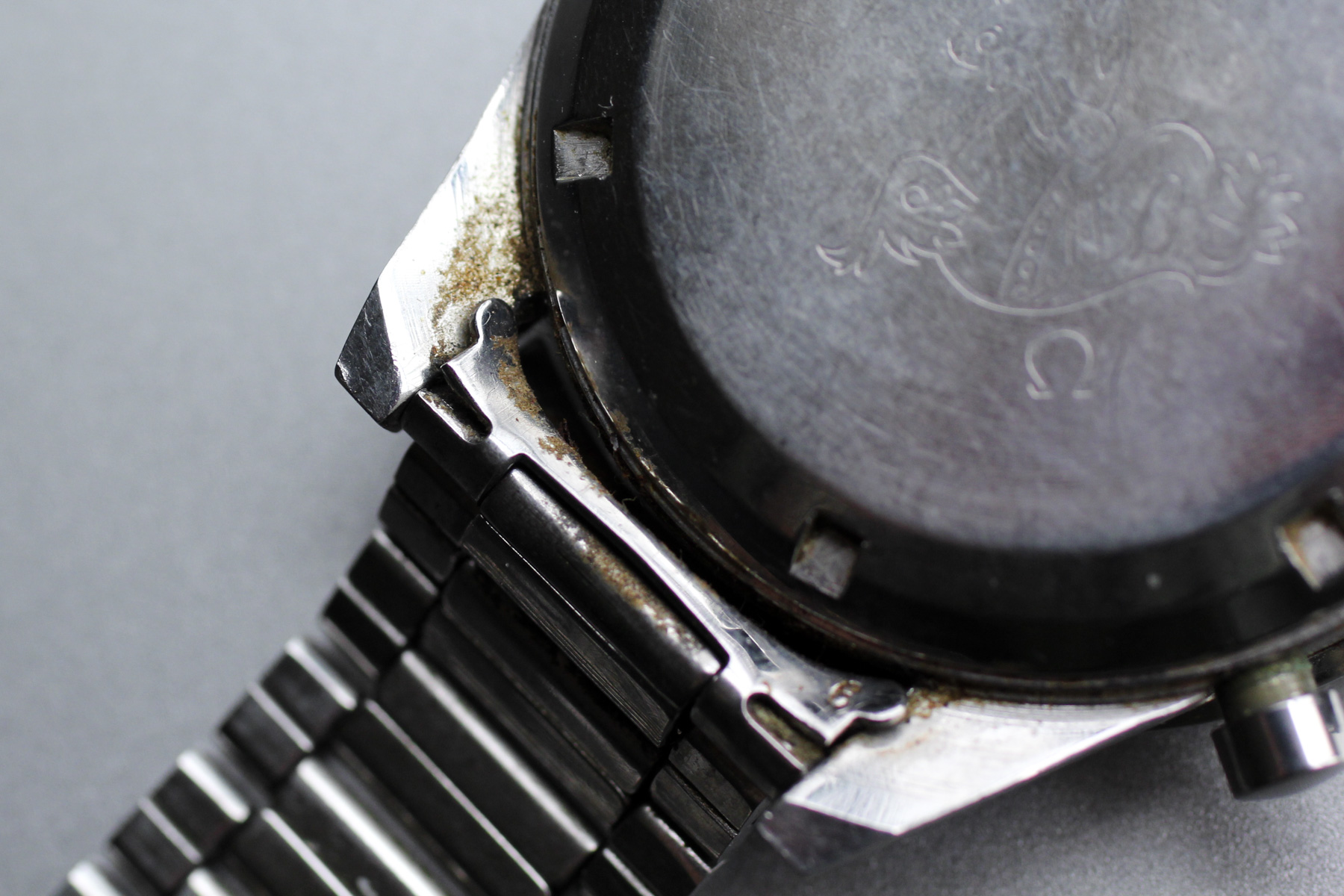
And the case – my, what a case! The original bevels were razor sharp and preserved to a degree that is rarely seen on any straight lug Speedmaster. The entire watch was such a dream that it prompted me to reach back out to the auction house to inquire about the origin of the example (which – yet again – is something I should have done prior to placing a bid in the auction). In order to protect the consignor’s privacy, the auction house would not let me reach out directly, and instead reached out on my behalf to inquire about the watch’s origin story. The story that came back was music to a collector’s ears.
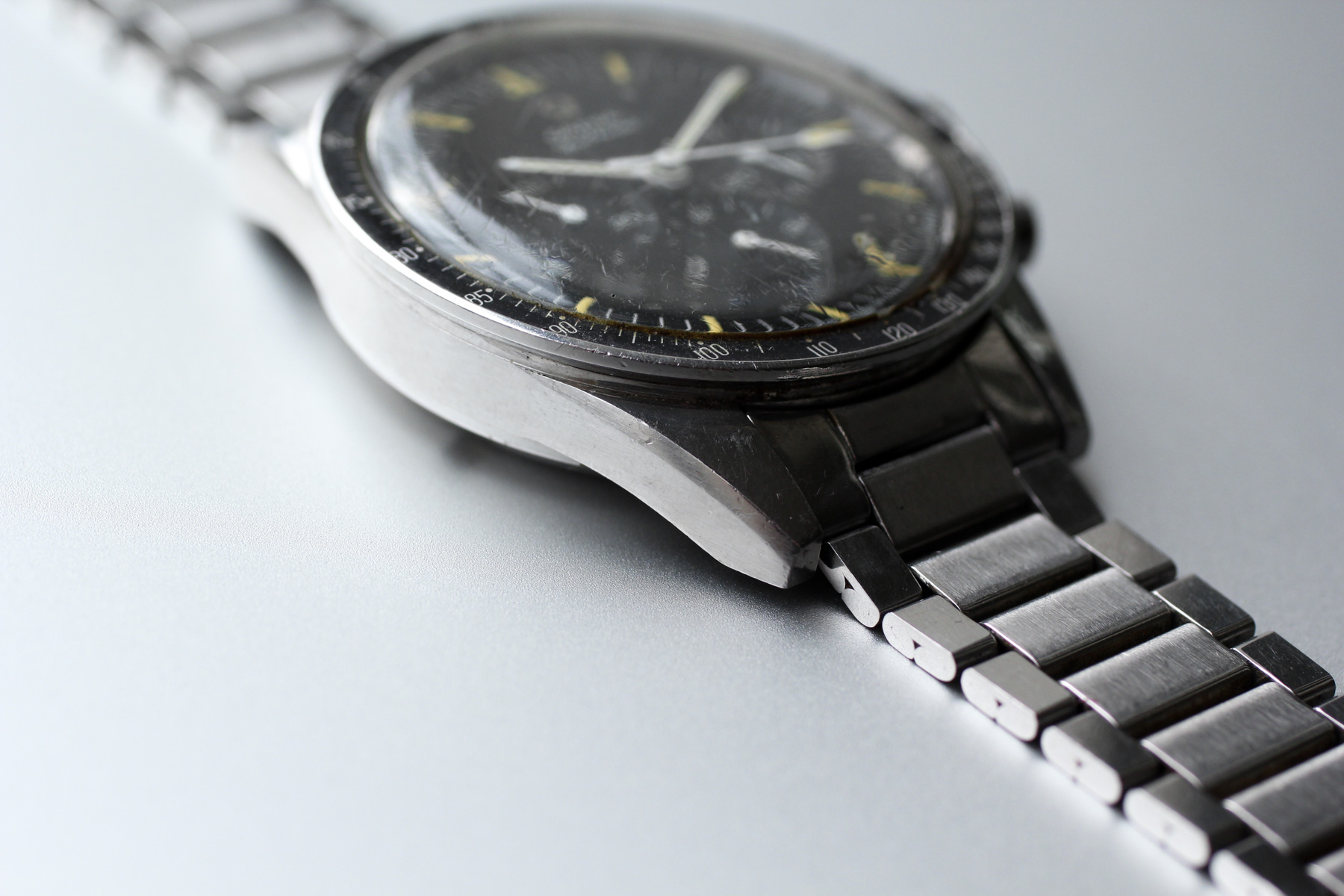
The message from the auction house read as follows:
“He bought the watch on June 11, 1967 while serving in the U.S. Army in Karlsrue, Germany. He bought it at the PX on base just a few weeks before he got home. He borrowed some money from a buddy to buy the watch – it was $142. He thought he had the box and warranty but has not yet found them. He said if he does locate those, he will send them along.”
Still no sign of the box and papers yet, but other than that, “The Gamble” proved to be a resounding winner. Just remember – do as I say, not as I do.



